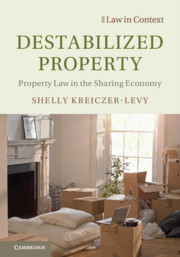Book contents
- Reviews
- Destabilized Property
- The Law in Context Series
- Destabilized Property
- Copyright page
- Dedication
- Contents
- Acknowledgments
- 1 Introduction
- 2 Stability and Property Use
- 3 The Decline of Stability in the New Millennium
- 4 The Rise of the Access Economy
- 5 Access as an Alternative to Ownership
- 6 Fragmentation of Intimate Property
- 7 Evaluating Flexibility in Property Use
- 8 What’s Next? The Future of the Access Economy
- 9 Conclusion
- Index
- Series page
2 - Stability and Property Use
Published online by Cambridge University Press: 25 October 2019
- Reviews
- Destabilized Property
- The Law in Context Series
- Destabilized Property
- Copyright page
- Dedication
- Contents
- Acknowledgments
- 1 Introduction
- 2 Stability and Property Use
- 3 The Decline of Stability in the New Millennium
- 4 The Rise of the Access Economy
- 5 Access as an Alternative to Ownership
- 6 Fragmentation of Intimate Property
- 7 Evaluating Flexibility in Property Use
- 8 What’s Next? The Future of the Access Economy
- 9 Conclusion
- Index
- Series page
Summary
The chapter establishes the centrality of stability in property law and theory today. It depicts and characterizes the legal protection of attachment, control, and possession as constituting a vision of stability. The chapter then analyzes and defends this conclusion along three categories: theories and justifications supporting the right to private property, legal doctrines, and doctrines that work to protect stable property relationships. It argues, following the famous Marxian distinction, that while property law accommodates a great level of flexibility in exchange value, it does not facilitate the same level of flexibility when it comes to use value. Use of physical property continues to be intimately tied to attachment and stability.
- Type
- Chapter
- Information
- Destabilized PropertyProperty Law in the Sharing Economy, pp. 16 - 37Publisher: Cambridge University PressPrint publication year: 2019

